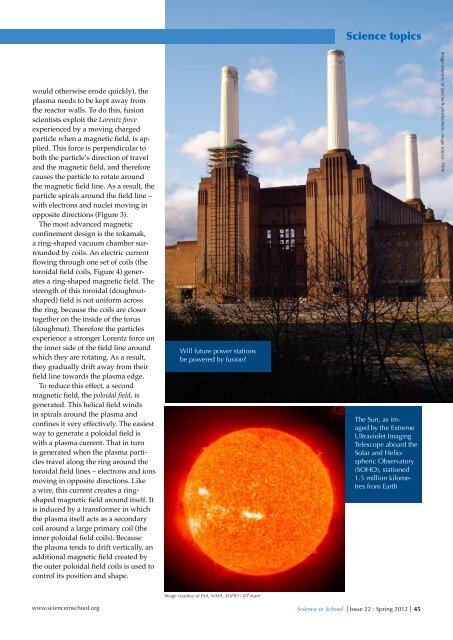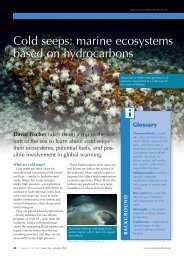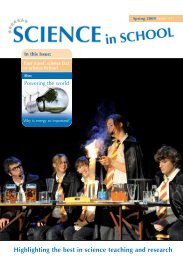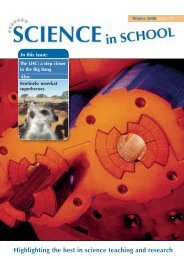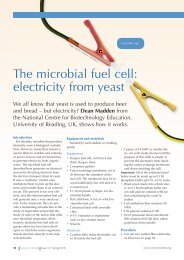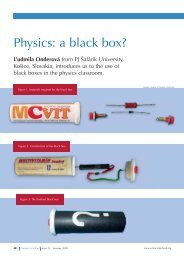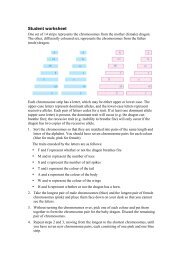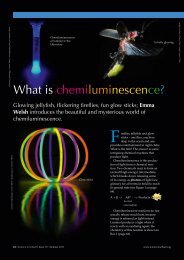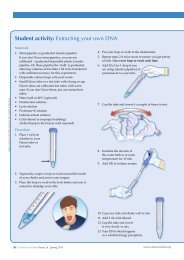Harnessing the power of the Sun: fusion reactors - Science in School
Harnessing the power of the Sun: fusion reactors - Science in School
Harnessing the power of the Sun: fusion reactors - Science in School
Create successful ePaper yourself
Turn your PDF publications into a flip-book with our unique Google optimized e-Paper software.
<strong>Science</strong> topics<br />
would o<strong>the</strong>rwise erode quickly), <strong>the</strong><br />
plasma needs to be kept away from<br />
<strong>the</strong> reactor walls. To do this, <strong>fusion</strong><br />
scientists exploit <strong>the</strong> Lorentz force<br />
experienced by a mov<strong>in</strong>g charged<br />
particle when a magnetic field, is applied.<br />
This force is perpendicular to<br />
both <strong>the</strong> particle’s direction <strong>of</strong> travel<br />
and <strong>the</strong> magnetic field, and <strong>the</strong>refore<br />
causes <strong>the</strong> particle to rotate around<br />
<strong>the</strong> magnetic field l<strong>in</strong>e. As a result, <strong>the</strong><br />
particle spirals around <strong>the</strong> field l<strong>in</strong>e –<br />
with electrons and nuclei mov<strong>in</strong>g <strong>in</strong><br />
opposite directions (Figure 3).<br />
The most advanced magnetic<br />
conf<strong>in</strong>ement design is <strong>the</strong> tokamak,<br />
a r<strong>in</strong>g-shaped vacuum chamber surrounded<br />
by coils. An electric current<br />
flow<strong>in</strong>g through one set <strong>of</strong> coils (<strong>the</strong><br />
toroidal field coils, Figure 4) generates<br />
a r<strong>in</strong>g-shaped magnetic field. The<br />
strength <strong>of</strong> this toroidal (doughnutshaped)<br />
field is not uniform across<br />
<strong>the</strong> r<strong>in</strong>g, because <strong>the</strong> coils are closer<br />
toge<strong>the</strong>r on <strong>the</strong> <strong>in</strong>side <strong>of</strong> <strong>the</strong> torus<br />
(doughnut). Therefore <strong>the</strong> particles<br />
experience a stronger Lorentz force on<br />
<strong>the</strong> <strong>in</strong>ner side <strong>of</strong> <strong>the</strong> field l<strong>in</strong>e around<br />
which <strong>the</strong>y are rotat<strong>in</strong>g. As a result,<br />
<strong>the</strong>y gradually drift away from <strong>the</strong>ir<br />
field l<strong>in</strong>e towards <strong>the</strong> plasma edge.<br />
To reduce this effect, a second<br />
magnetic field, <strong>the</strong> poloidal field, is<br />
generated. This helical field w<strong>in</strong>ds<br />
<strong>in</strong> spirals around <strong>the</strong> plasma and<br />
conf<strong>in</strong>es it very effectively. The easiest<br />
way to generate a poloidal field is<br />
with a plasma current. That <strong>in</strong> turn<br />
is generated when <strong>the</strong> plasma particles<br />
travel along <strong>the</strong> r<strong>in</strong>g around <strong>the</strong><br />
toroidal field l<strong>in</strong>es – electrons and ions<br />
mov<strong>in</strong>g <strong>in</strong> opposite directions. Like<br />
a wire, this current creates a r<strong>in</strong>gshaped<br />
magnetic field around itself. It<br />
is <strong>in</strong>duced by a transformer <strong>in</strong> which<br />
<strong>the</strong> plasma itself acts as a secondary<br />
coil around a large primary coil (<strong>the</strong><br />
<strong>in</strong>ner poloidal field coils). Because<br />
<strong>the</strong> plasma tends to drift vertically, an<br />
additional magnetic field created by<br />
<strong>the</strong> outer poloidal field coils is used to<br />
control its position and shape.<br />
Will future <strong>power</strong> stations<br />
be <strong>power</strong>ed by <strong>fusion</strong>?<br />
The <strong>Sun</strong>, as imaged<br />
by <strong>the</strong> Extreme<br />
Ultraviolet Imag<strong>in</strong>g<br />
Telescope aboard <strong>the</strong><br />
Solar and Heliospheric<br />
Observatory<br />
(SOHO), stationed<br />
1.5 million kilometres<br />
from Earth<br />
Image courtesy <strong>of</strong> spectacle productions; image source: Flickr<br />
Image courtesy <strong>of</strong> ESA, NASA, SOHO / EIT team<br />
www.science<strong>in</strong>school.org <strong>Science</strong> <strong>in</strong> <strong>School</strong> I Issue 22 : Spr<strong>in</strong>g 2012 I 45


